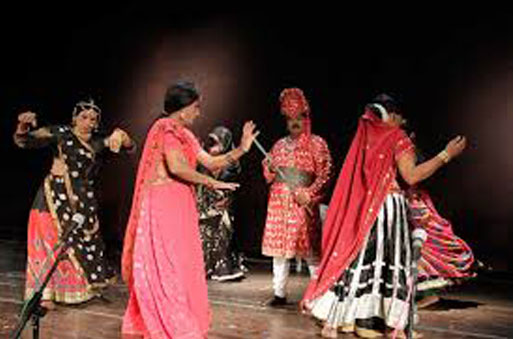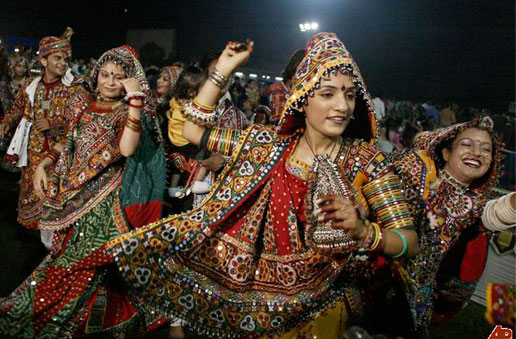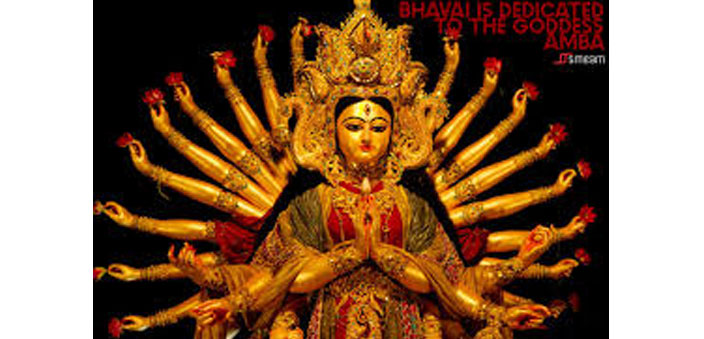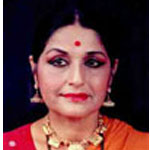Come the month of ‘Ashvin’, after the rains, and the whole of Gujarat throbs with the beat of the drums which can be heard from every nook and corner. The drums are accompanied by the shrill note of shehnai and large cymbals called traansaa. Almost every, home rich or poor, participates in the festivities. This is the time of ‘Navaraatri’ – the nine day festival dedicated to Goddess Ambaa representing Shakti or Devi. On every street corner or crossroad, groups of women dance the ‘garba’, which is danced in a circle. The women dance round an earthenware pot ghata which has little holes all over its body, with a small oil lamp placed in it which sends soft rays of the flame through the little holes. This light represents the Supreme Female Energy (Shakti) and is a symbol of fertility. This is the season when the crops have been harvested and a very pleasant weather prevails. Grateful people thank the Supreme Shakti for granting fertility to the land and for nurturing an abundant crop.

The origin of Bhavai
Bhavai owes its origins to a person named Asitaa, an Audichya Brahmin of Unjha, in Mehsana district. Asitaa had been excommunicated for having rescued and married a low caste girl. He was reputed to be a good singer and actor, and he began to compose and perform Bhavaai after being shunned by the society. His descendants comprise the large community called Bhavaayaa. They are sub-divided into two major groups – the ‘Bhojakas’ and the ‘Nayakas’. Today they perform in a group called Mandali, and travel from village to village and are sustained by the villagers.
In adjoining Rajasthan, a similar development appears to have occurred wherein a person called Naagaaji was excommunicated for his love of music and dance. He was given a nagaaraa and a bhungal – which are the typical musical instruments of Bhavai. His descendants are called the Bhavai actors of Rajasthan – like in Gujarat, these people are devotees of Ambaa Devi or Shitalaa Devi – the Goddess of small pox.
In both these areas, it transpires that the performance of Bhavai is not restricted to these backward class groups, and during Navaraatri, all strata of society participates in the performance.
The performance of Bhavai
The performance of Bhavai can be near a temple or in an open space. A large number of ‘mandapas’ called mandavo in Gujarat are erected and are decorated with palm leaves, flowers etc. Of special beauty are the wall decorations made up of patch work, applique work and aabhalaa work (mirror work). The four poles in the corners are decorated with curtains made of bead-work (keediyaa).
Whatever the community, the first act of the actor is to bow to the earthen pot, the ghata (or garbo) and seek blessings of ‘Ambaa-Maa’ representing the Supreme Shakti (Energy).
The prayer to the Goddess is sung by the Naayaka who acts as the sutradhar and the musicians. After the prayer, the actors enter the demarked performance arena called paudh and one of them performs the ‘Ganesha Vesha’, which is remarkable since he does not wear a mask. Then comes the ‘Bhahman Vesha’ which is followed by an interlude called ‘Kabaa and his wife Jatadi’. After these three rituals there can be presented any selected story or stories.

After the three preliminary rituals come the story or stories; some are mythological like Kaanhaa-gopi (Krishna-gopi), Raama-Raavana, Ardhanaareeshvara and historical stories typical to Gujarat like Jasmaa Odan, Ramdev, Jaisingh etc. Interspersed within the fabric of the stories are sound social themes which expose hypocrisy of the upper class ills within the society.
The performance is set to duhaas, chaupais, songs and prose passages – all handled with dexterity by the Naayaka and the other actors.
Dance is presented in Bhavai through the solo dancing of the actors who play female roles, as also through a variety of group dances. In these sections, the typical steps and movement patterns of the ‘garba’ and ‘garbi’ (typical folk dances of Gujarat which are now world famous) are freely used. Like other performances of this genre, dancing is an integral part of the theatrical spectacle and not an embellishment; dance in Bhavai cannot be dispensed with.
The costumes are a mix of the historical and the modern. Woman characters are dressed in different garments like the women of Gujarat – usually a long skirt (chaniya) etc., but the odhani (half-sari) is a must. The married woman is presented by the odhani covering the face, the unmarried by her face uncovered. Turbans (pagdis) worn by men indicate their social status.
The lighting is provided by the barber (hajaam) who stands with lighted torches on wooden or bamboo poles half way along the depth of the stage or the paudh (acting arena). He flashes these torches against the faces of the actors at dramatic moments and follows some actors freely along the stage as they act, sing and dance.
It’s a sad state of affairs that in recent times, the Bhavai performances have gradually shed their puranic or mythological base and turned more and more towards social issues. The satire, instead of being subtle, became very pedestrian and sometimes bordered on being vulgar.
Yet there have been geniuses who have brought in a fresh approach. One such individual was Jaishankar Bhojak “Sundari” in the 1930s and 1940s – a veteran actor who presented popular Gujarati plays in the form of Bhavai, and took the female roles himself. This revivalist activity was bolstered by very famous Gujarati performers who brought in a fresh interpretation to the content of Bhavai and polished the presentation technique to suit the changing social environment.


 [/column]
[/column]